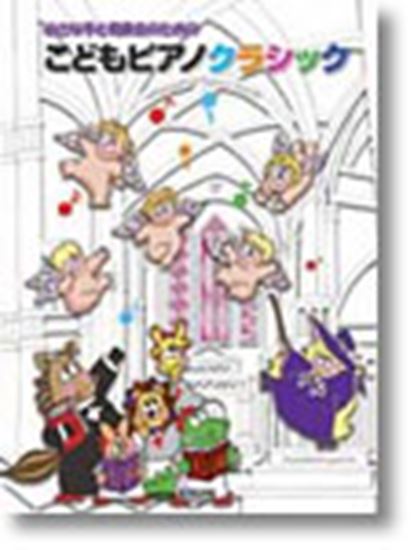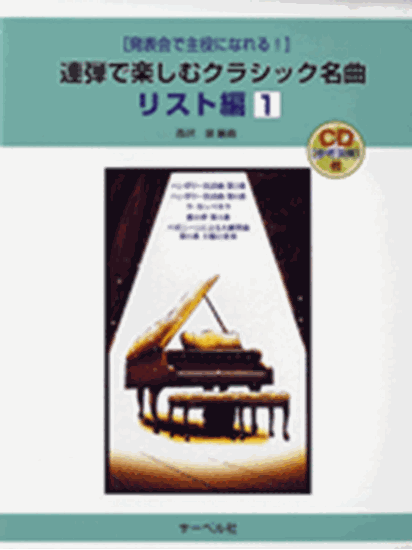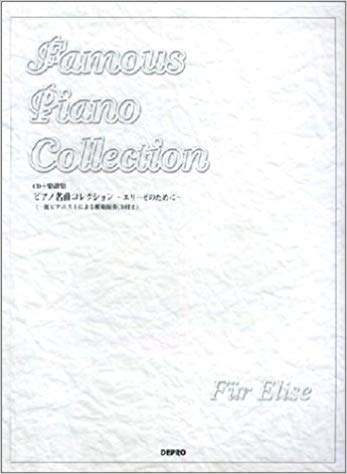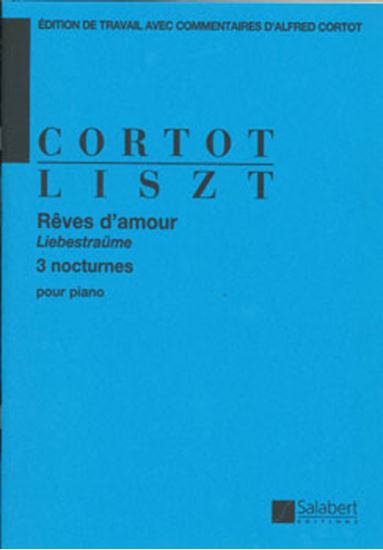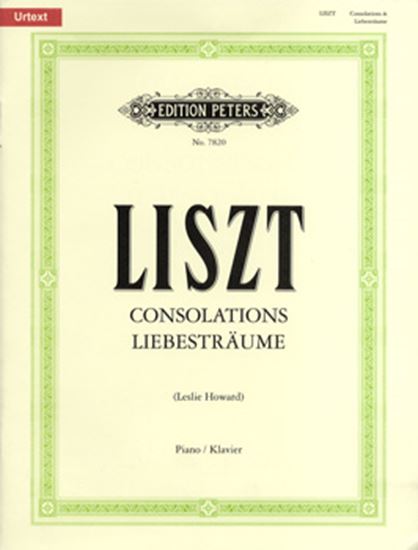Liszt, Franz : Liebestraume - 3 notturnos S.541 R.211
Work Overview
Instrumentation:Piano Solo
Genre:pieces
Total Playing Time:14 min 30 sec
Copyright:Public Domain
Commentary (1)
Author : Ito, Moeko
Last Updated: November 1, 2009
[Open]
Author : Ito, Moeko
Originally written as solo songs for soprano, these works were composed as piano solo pieces by Liszt at age 39 in 1850 and published the same year as "Liebesträume – Three Nocturnes." Looking at Liszt's activities around this time, it is notable that he became Kapellmeister at the Weimar court in 1848. This appointment came after he resigned from approximately 10 years of concert activities, and it was intended to place composition at the center of his life.
Weimar was a city where literary giants like Goethe, Schiller, and Herder were active, and historically, J.S. Bach also flourished there. Liszt composed and presented works for major celebratory events, such as the centenary of Goethe's birth in 1849. Among these, he presented the overture for Goethe's drama Tasso (later revised and re-performed as the symphonic poem Tasso in 1854, at which time the term "Symphonische Dichtung" was first used) and the Faust Symphony (1854).
He also actively supported contemporary composers, frequently performing works by Berlioz and Schumann. In 1850, he conducted the world premiere of Wagner's romantic opera Lohengrin. Liszt was extremely active, not only performing these works but also publishing writings to promote understanding of them. The activities mentioned above bore fruit not only in orchestral works but also in numerous paraphrases for solo piano.
For the following explanations, information about the solo songs is provided first, followed by information about the piano arrangements.
No. 1 in A-flat major "Hohe Liebe"
As a solo song (S307) based on a poem by the German poet Johann Ludwig Uhland (1787-1862), the first version was completed and published in 1850. (The second version was completed in 1854.) The poem's content is about gladly abandoning earthly joys to become a martyr.
In the piano arrangement composed and published in 1850, the original song is first largely transcribed as is, after which the graceful theme is repeated amidst a brilliant impression, with frequent use of decorative figures in the high register.
No. 2 in E major "Gestorben war ich"
Similar to No. 1, it was completed in 1846 and published in 1850 as a solo song (S308) based on a poem by Uhland. The gist of the poem is: "I died before the joy of love. Buried in her arms, I awoke with her kiss, and saw heaven in her eyes."
In the piano arrangement composed and published in 1850, the section up to the double bar corresponds to the original song, but it is arranged more pianistically compared to No. 1. The theme then reappears with ornamentation, but the subsequent phrase of the theme is dramatically built up by repeated chords.
As a related work, the first piece in E major from "Five Piano Pieces," completed in 1865, can be mentioned.
No. 3 in A-flat major "O lieb, so lang du lieben kannst!"
This is one of the most popular short pieces among Liszt's works. As a solo song (S298) based on a poem by the German poet Hermann Ferdinand Freiligrath (1810-1876), it was composed around late 1843, and its first edition was published in 1847. The second version was completed and published in 1850.
The poem, beginning with "O lieb, so lang du lieben kannst!" (O love, as long as you can love!), is not about romantic love but about human love. Its content is: "The time will come when you will lament before a grave. Therefore, love as long as you can love. If someone opens their heart to you, devote yourself to them and never cause them sorrow. And be careful how you speak, for bad words quickly escape the mouth. Even if you say, 'God, it was a misunderstanding!', that person will lament and depart."
The difference from the song version is the passage just before the opening theme is recapitulated. In the song, this section corresponds to the line "Und huete deine Zunge wohl, ..." (And guard your tongue well, ...), taking the form of an alternating performance between the vocal and piano parts, creating a recitative-like section (a musical passage used in operas, oratorios, and cantatas to explain situations or individual feelings, or for narrative purposes). In the piano arrangement, this passage does not exist; instead, a different melody is used to form the climax of the piece, adorned with rich ornamentation, leading into the recapitulation of the opening theme.
Movements (3)
Arrangements & Related Works(8) <Show>
Thompson, John Sylvanus: Modern Course for the Piano 2 *in preparation*
Total Performance Time: 1 min 30 sec
yamaha music foundation & yamaha music media corporation: 大人のためのピアノ悠々塾 基礎編 改訂版 11. 愛の夢(リスト)
Total Performance Time: 0 min 50 sec
Hashimoto, Koichi: ピアノひけるよ!シニア2 20. 愛の夢(リスト)
Total Performance Time: 1 min 30 sec
PTNA & Partner Channel Videos(20items) View More
Sheet MusicView More
Scores List (144)

(株)ドレミ楽譜出版社

(株)全音楽譜出版社

KMP(ケイ・エム・ピー) ケイエムピー

(株)シンコーミュージックエンタテイメント

(株)全音楽譜出版社

(株)ヤマハミュージックエンタテインメントホールディングス

(株)全音楽譜出版社

(株)全音楽譜出版社

(株)ドレミ楽譜出版社

(株)音楽之友社

KMP(ケイ・エム・ピー) ケイエムピー

KMP(ケイ・エム・ピー) ケイエムピー

(株)ドレミ楽譜出版社

ミュージックランド

ミュージックランド

ミュージックランド

ミュージックランド

(株)ドレミ楽譜出版社

(株)共同音楽出版社

(株)リットーミュージック

KMP(ケイ・エム・ピー) ケイエムピー

ミュージックランド

ミュージックランド

(株)シンコーミュージックエンタテイメント

(株)シンコーミュージックエンタテイメント

(株)シンコーミュージックエンタテイメント

(株)シンコーミュージックエンタテイメント

(株)リットーミュージック

(株)シンコーミュージックエンタテイメント

(株)ヤマハミュージックエンタテインメントホールディングス

(株)シンコーミュージックエンタテイメント

ミュージックランド

KMP(ケイ・エム・ピー) ケイエムピー

(株)全音楽譜出版社

ミュージックランド

(株)ドレミ楽譜出版社

(株)シンコーミュージックエンタテイメント

ミュージックランド

(株)シンコーミュージックエンタテイメント

(株)ヤマハミュージックエンタテインメントホールディングス

(株)リットーミュージック

ミュージックランド

(株)ドレミ楽譜出版社

カワイ出版

(株)ヤマハミュージックエンタテインメントホールディングス

ハンナ(ショパン)

ミュージックランド

ミュージックランド

KMP(ケイ・エム・ピー) ケイエムピー

(株)ドレミ楽譜出版社

(株)ヤマハミュージックメディア

(株)シンコーミュージックエンタテイメント

(株)ドレミ楽譜出版社

KMP(ケイ・エム・ピー) ケイエムピー

(株)ヤマハミュージックエンタテインメントホールディングス

(株)シンコーミュージックエンタテイメント

KMP(ケイ・エム・ピー) ケイエムピー

(株)シンコーミュージックエンタテイメント

ハンナ(ショパン)

ハンナ(ショパン)

ハンナ(ショパン)

(株)全音楽譜出版社

(株)シンコーミュージックエンタテイメント

(株)シンコーミュージックエンタテイメント

(株)ヤマハミュージックエンタテインメントホールディングス

(株)ヤマハミュージックエンタテインメントホールディングス

(株)ヤマハミュージックエンタテインメントホールディングス

(株)ヤマハミュージックエンタテインメントホールディングス

KMP(ケイ・エム・ピー) ケイエムピー

KMP(ケイ・エム・ピー) ケイエムピー

ハンナ(ショパン)

ハンナ(ショパン)

(株)ヤマハミュージックエンタテインメントホールディングス

(株)シンコーミュージックエンタテイメント

(株)ヤマハミュージックエンタテインメントホールディングス

KMP(ケイ・エム・ピー) ケイエムピー

(株)全音楽譜出版社

(株)ドレミ楽譜出版社

(株)ドレミ楽譜出版社

KMP(ケイ・エム・ピー) ケイエムピー

(株)シンコーミュージックエンタテイメント

(株)ヤマハミュージックエンタテインメントホールディングス

ミュージックランド

(株)シンコーミュージックエンタテイメント

(株)ヤマハミュージックエンタテインメントホールディングス

(株)ドレミ楽譜出版社

ミュージックランド

(株)ヤマハミュージックエンタテインメントホールディングス

(株)共同音楽出版社

(株)ドレミ楽譜出版社

ミュージックランド

(株)シンコーミュージックエンタテイメント

デプロMP

(株)シンコーミュージックエンタテイメント

(株)シンコーミュージックエンタテイメント

ミュージックランド

(株)タイムリーミュージック

(株)全音楽譜出版社

ミュージックランド

(株)全音楽譜出版社

(株)全音楽譜出版社

KMP(ケイ・エム・ピー) ケイエムピー

(株)ヤマハミュージックエンタテインメントホールディングス

(株)シンコーミュージックエンタテイメント

KMP(ケイ・エム・ピー) ケイエムピー

(株)ドレミ楽譜出版社

(株)シンコーミュージックエンタテイメント

(株)シンコーミュージックエンタテイメント

(株)シンコーミュージックエンタテイメント

ミュージックランド

(株)シンコーミュージックエンタテイメント

KMP(ケイ・エム・ピー) ケイエムピー

(株)シンコーミュージックエンタテイメント

(株)シンコーミュージックエンタテイメント

(株)自由現代社

(株)ヤマハミュージックエンタテインメントホールディングス

(株)ヤマハミュージックエンタテインメントホールディングス

(有)中央アート出版社

(株)春秋社

ミュージックランド

ハンナ(ショパン)

ヘンレー

ショット社/ドイツ

ヘンレ社(ヤマハ)

ムジカ・ブダペスト社

(株)オンキョウパブリッシュ〇

(株)ヤマハミュージックエンタテインメントホールディングス

(株)ヤマハミュージックエンタテインメントホールディングス

(株)音楽之友社

(株)学研プラス

Musikverlag Doblinger

Musikverlag Doblinger

EMB

ミュッセ

ミュッセ

(株)ヤマハミュージックエンタテインメントホールディングス



















